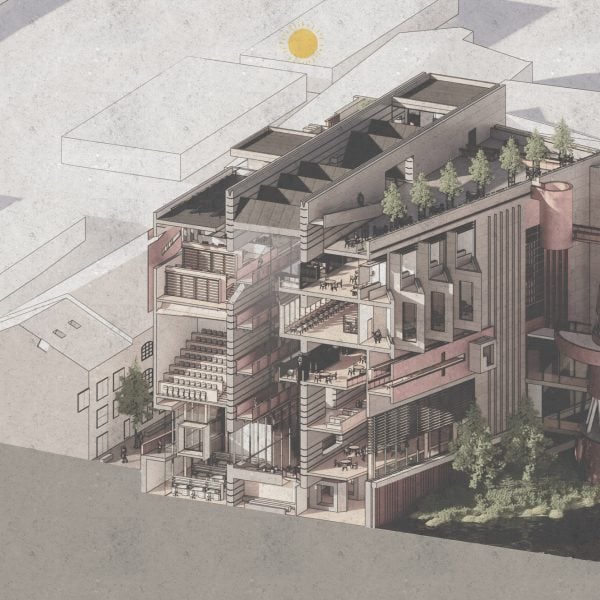Dezeen School Shows: a project addressing the impact of technology on mental health through the redesign of a social housing scheme is included in this school show by students at the University of Nottingham.
Also included is a scheme intended to restore the health of the River Avon in southwest England through sustainable methods and a library that honours different cultures among local agriculture.
Institution: University of Nottingham
School: Department of Architecture and Built Environment
Courses: ARB/RIBA accredited courses
Tutors: Tim Collett and Margaret Mulcahy
School statement:
“The Department of Architecture and Built Environment at the University of Nottingham is ranked top 100 department/school of architecture in the world and sixth in the UK by the QS World University Rankings by Subject 2024, consistently ranked within the top ten for architecture in all major UK guides.
“We provide purpose-built design studios set in the heart of our Green Flag Award-winning University Park Campus, widely regarded as one of the most attractive UK campuses and only two miles from Nottingham’s city centre.
“We offer ARB/RIBA accredited courses that focus on developing design excellence to tackle the most significant issues affecting our communities and cities.
“Our students have the opportunity to develop their passion and become exceptional architects, engineers and built environment professionals, who help make a greener planet spin a little smoother and improve people’s lives.
“This is the place where we design the places of tomorrow.
“The quality of work coming out of our courses is shown by our success in a number of student competitions, including the RIBA President’s Bronze Medal award programme and the Serjeant prize.
“Take a look at some of the stand-out projects from this year’s end-of-year show.”
The North Woolwich Community: Makers and Creators by Eve Bailey
“This thesis takes the idea of creating and maintaining ambiguity, allowing the site’s history to prevail despite modern interventions.
“In a flood risk area, the impact of the temporal ambiguity created by the water helps create a future-proofed design in the current climate crisis.
“This includes a programme which fosters community, creating inclusive spaces for all.
“The ethos of studio two includes the importance of creating architectural interventions which become public contributions to the city.
“This is highlighted by the creation of multiple charged ground planes, with the flexible markets occupying the flood level, creating areas which can become flooded.”
Student: Eve Bailey
Course: MArch Architecture (ARB/RIBA Part 2)
Tutors: Nick Haynes and Laura Hanks
Email: eab99[at]hotmail.co.uk

Wapping Wall Gardens by Jess Ellis
“Studio continuity’s ethos encourages a careful reading of existing buildings, to allow for thoughtful interventions that are connected to history, character and ambience of place.
“This project explores three key ideas inspired by nature and gardening – grafting new onto old, reappropriating waste materials and armature – to develop an ecological model for working within existing buildings.
“The project utilises timber frame structures, grafted onto the existing and combined with materials harvested from sites (recycled aggregate, cobbles and reclaimed brick) to transform the existing building into Wapping Wall Gardens, a community garden and education centre, with a new cyclical architectural language and aesthetic.”
Student: Jess Ellis
Course: MArch Architecture (ARB/RIBA Part 2)
Tutors: Tim Collett and Naomi Eckworth
Email: jessicaellis[at]me.com
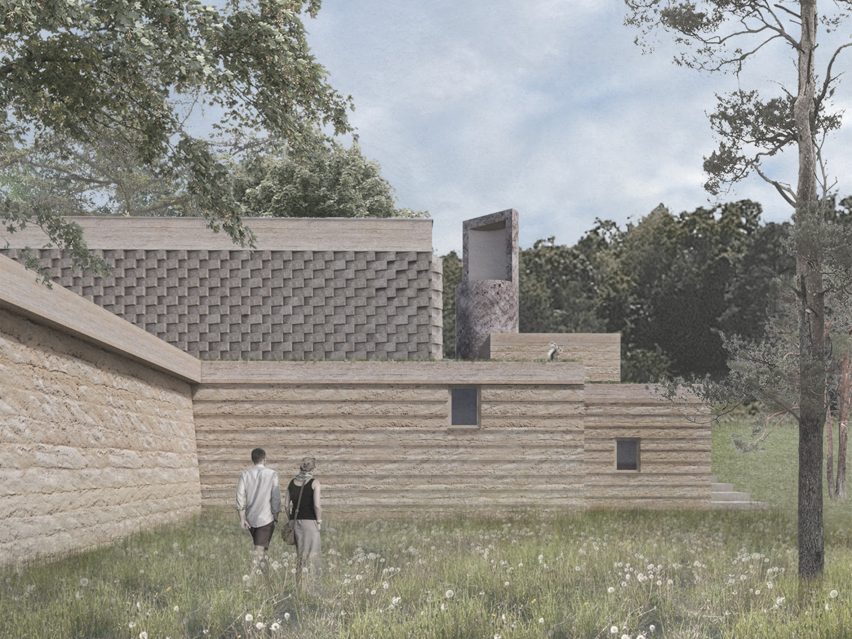
Transcending Space: Bridging the Profane into Sacred by Saad Thobani
“The design orchestrates an architectural pilgrimage culminating in a multi-faith sanctuary.
“This journey embraces architectural elements to guide visitors from the profane to the sacred – as they progress, the design creates intentional transitions through spaces that elevate their experience.
“The pilgrimage concludes at the multi-faith centre, where architecture transcends cultural and religious boundaries.
“This sanctuary unifies diverse beliefs, nurturing a shared space for spiritual reflection and solace.
“The project exemplifies how thoughtful design can craft an inclusive environment that honours the sacred across various faiths.”
Student: Saad Thobani
Course: MArch Architecture (ARB/RIBA Part 2)
Tutors: Graham Mateer and Will Gottelier
Email: thobanisaad1[at]gmail.com
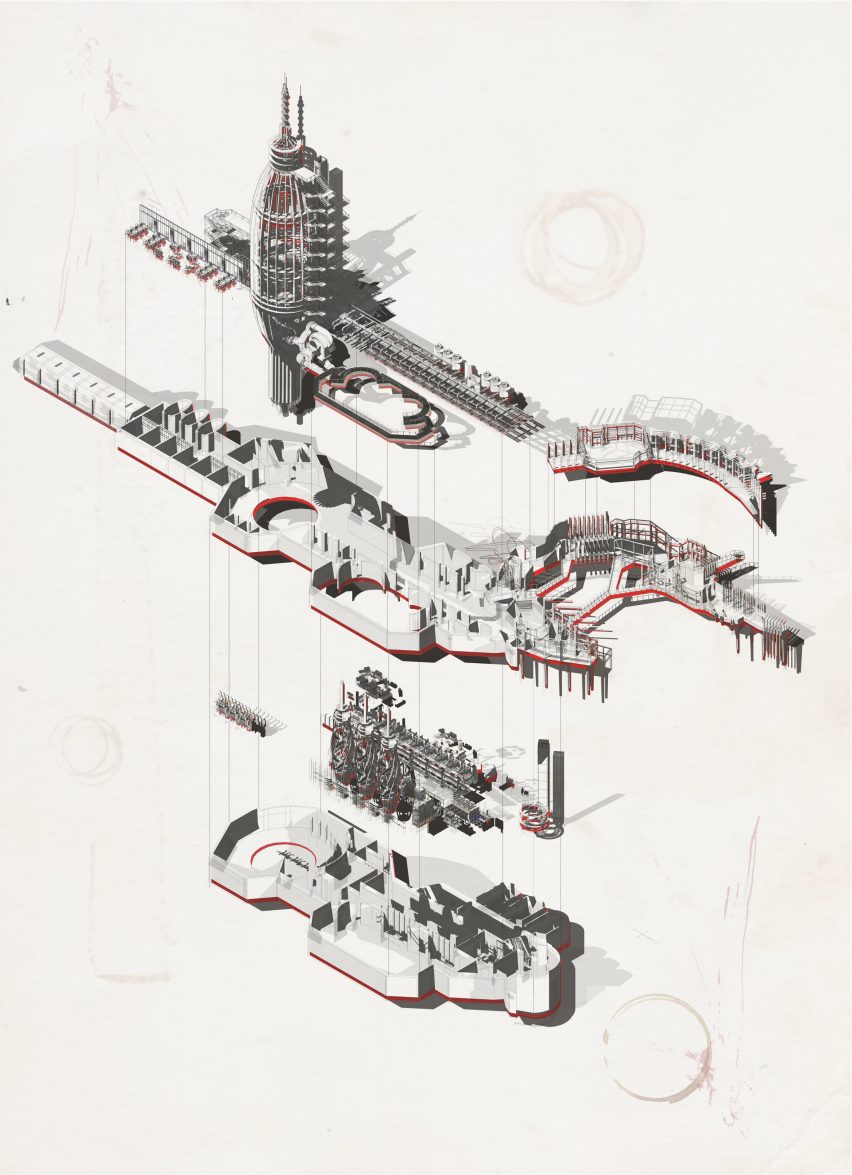
Liminality – The Defeat of Evolutionary Anthropocentricit by Amelie Badesha
“As natural and artificial realms blur and humans merge with machines, my project, located in Bath’s old railway Combe Down Tunnel, proposes a meditative retreat for rehabilitation.
“It counters technology-induced dependency and promotes autonomy, functioning as a monastic landscape to reconnect with one’s consciousness.
“It serves as a therapeutic tool for healing the mind in a digital world.
“Below this retreat, within the existing tunnel lies a contrasting microchip factory and insertion centre where individuals can become fully digitally connected.
“This contrast highlights the retreat as a final barrier against a dystopian future of complete digital immersion, offering a sanctuary to reconnect with oneself and resist the pervasive influence of technology.”
Student: Amelie Badesha
Course: Bachelor of Architecture BArch (ARB/RIBA Part 1)
Tutors: Margaret Mulcahy and Charlotte Simpson
Email: amelie.badesha[at]gmail.com

The Future Foundry by Isabella Foote
“The Future Foundry works with the abandoned Haslam’s Foundry situated in Derby.
“The project ensures the scheme functions as non-wasteful and self-sufficient through systems like irrigation ponds and natural flood defences.
“The project embraces the River Derwent through expanding the riverbed and welcoming the local ecology.
“Within The Future Foundry, the living lab scheme is born, focusing on what we can learn from nature in both controlled and field environments.
“Following a ‘science on show’ approach, the scheme works closely with the community to test findings from the lab, to then implement back into the wider context.”
Student: Isabella Foote
Course: Architecture BArch (ARB/RIBA Part 1)
Tutor: Adam Swain-Fossey
Email: isabellafoote7[at]gmail.com

Make Do and Mend – An Antidote to Cathedrals of Consumption by Michelle Giljam
“The project inhabits the 1960s city arcade on the edge of the once revolutionary shopping precinct in Coventry.
“Aiming to protest the surrounding overconsumption, the arcade transforms into a new way to dwell in the urban realm, providing space to buy items you need, donate the things you don’t and repair what is broken.
“The approach to the building reflects this, made from repairing, reusing, repurposing, recycling and upcycling the existing building.
“The scheme has a church-like quality, contrasting the homogeneity of shopping centres, to foster an appreciation for the everyday things we take from the earth.”
Student: Michelle Giljam
Course: Architecture and Environmental Design MEng (ARB/RIBA Part 1 CIBSE)
Tutors: Amanda Harmer and Matt Strong
Email: mgiljam[at]hotmail.co.uk
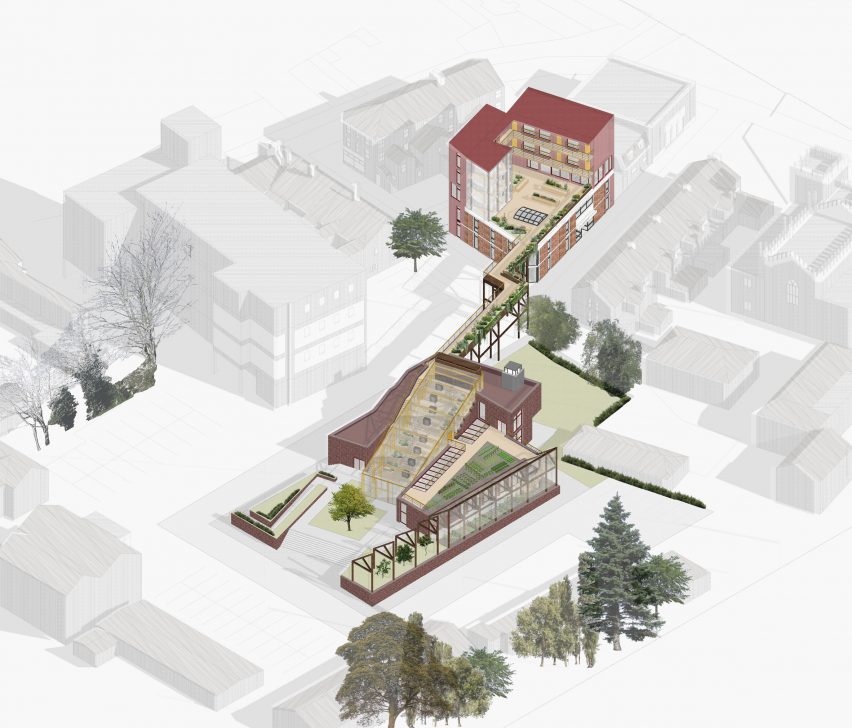
Dos-à-dos libraries, Spalding by Minjae Kim
“This scheme consists of two interconnected libraries for a migrant community and locals, one where migrants may tackle their homesickness and one where locals can appreciate their hometown.
“It revitalises the city’s surrounding territory and fosters a vibrant culture.
“The initiative exposes participants to two distinct cultures in quick succession, fostering harmony between them.
“By means of two programs – one for a conventional library space and the other for a public third library space – to cultivate, harvest, manufacture and enjoy the fusion of Spalding’s agricultural culture and the eating culture of Eastern European farm workers, the worth of books will be preserved.”
Student: Minjae Kim
Course: Architecture BArch (ARB/RIBA Part 1)
Tutors: Farida Makki, Diogo Real and Caoimhe Hughes
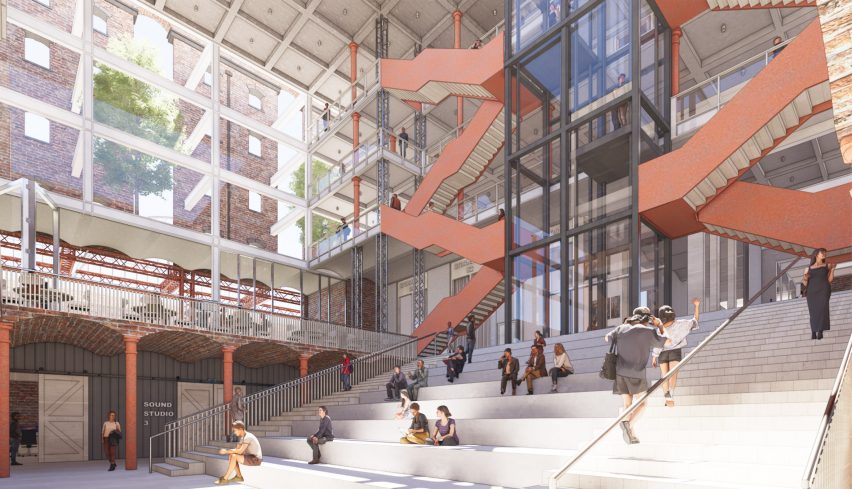
The Alchemy of the Retrofit Renaissance: Creating an Urban Node for Film Education by Brooke Wilson
“Stanley Dock embodies the essence of forgotten places.
“Once a bustling hub, it now exists in relative obscurity, appreciated by a select few who recognise its historical richness, notably filmmakers who discern its potential as a cinematic backdrop.
“Its acclaim as a premier filming location underscores the pressing need for specialised infrastructure.
“My proposal unveils a visionary masterplan integrating educational facilities and black box studios amidst neighbouring redevelopment initiatives.
“Inspired by filmmakers’ discerning gaze, the design retrofits a 19th-century brick warehouse, preserving brick arch ceilings and cast iron columns where feasible, while elegantly showcasing the original building’s structural grid throughout.”
Student: Brooke Wilson
Course: Architecture BArch (ARB/RIBA Part 1)
Tutor: Alisdair Russell
Email: blwilson2001[at]gmail.com
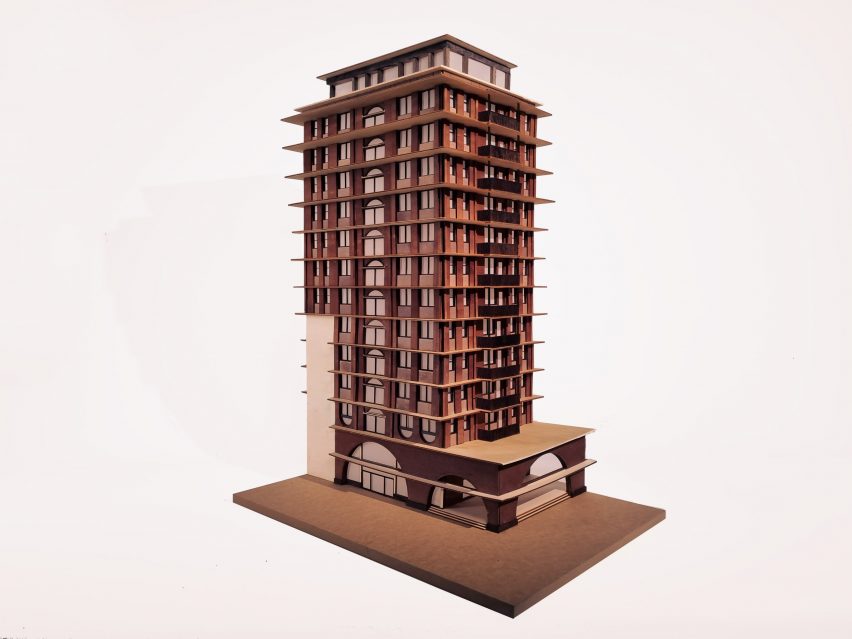
Finding Time in Space by Adam Bridson
“The project aims to enhance social housing through design driven by mindfulness, by revitalising an existing housing scheme in the City of Westminster.
“With the rapid advancement of technology, the pace of life is constantly increasing.
“This can negatively impact our wellbeing, relationships and environment.
“Architecture has the potential to shape the temporal and spatial experiences of individuals by utilising shadows and spatial relationships to slow users down into the present moment.
“This proposal envisions creating homes that offer refuge from the speed of the outside world, fostering environments where residents can reconnect with themselves and their surroundings.”
Student: Adam Bridson
Course: MArch Architecture (ARB/RIBA Part 2)
Tutors: Graham Mateer and Will Gottelier
Email: bridsonac1[at]gmail.com
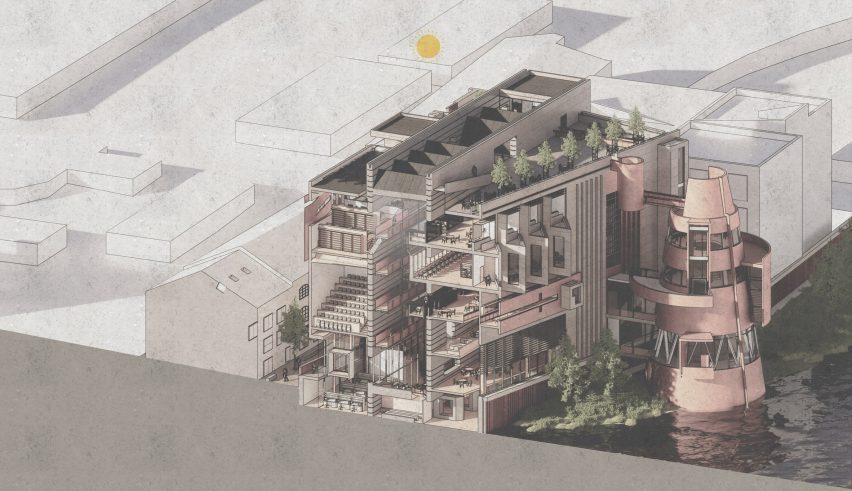
TRI: The Rodda Institute of Hydrology and Conservation by Maia Noglik
“Located in Bath, the scheme adapts to restore the overall health of the River Avon which has been in a state of rapid decline affecting the surrounding inhabitants – animal and human.
“The scheme aims to become a gateway to the site, building forms off of the existing flood wall geometry and using elevational treatment to break the stereotype of the original harsh barrier between the river and site.
“The project is driven by building uniquely to a fusion of education, research and community – a new hub of interdisciplinary collaboration driven by sustainable restoration, inspired and reflecting the historical and cultural qualities of Bath.”
Student: Maia Noglik
Course: Architecture BArch (ARB/RIBA Part 1)
Tutor: Jim Hutcheson
Email: maia[at]department27.com
Partnership content
This school show is a partnership between Dezeen and the University of Nottingham. Find out more about Dezeen partnership content here.

